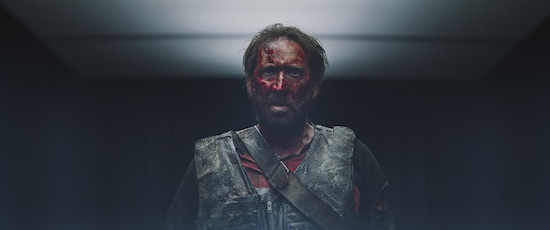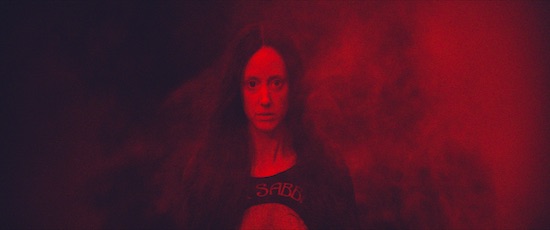Imagine a room. On the wall hangs a print of Frank Frazetta’s Death Dealer – that iconic fantasy image of a demonic barbarian warrior holding a massive axe. Wreathed in shadow with only two burning ruby red eyes shining from underneath his horned helm, he sits astride a muscular warhorse in the middle of a grey volcanic wasteland. Weed smoke fills the air of the room as a set of speakers blast Black One by SUNN O))), a menacing wall of droning sound that sweeps through the space like a wave of pure sonic anxiety. A small television in the corner plays a well-worn ex-rental VHS copy of Conan: The Destroyer, and the floor is littered with other tapes: Hercules in the Haunted World, Hellraiser, Friday the 13th Part VII, Fire and Ice, Evil Dead 2, Krull, Death Wish, Nightbeast.
On the bookshelves are a carefully curated selection of premium grimdark fantastique; the full 39 volume set of Kentaro Miura’s bloody manga epic Berserk, ancient issues of Metal Hurlant, the complete works of Robert E. Howard, the Hawkmoon novels of Michael Moorcock, Dark Souls: Design Works, and The Dungeon Master Guide, Second Edition. Hanging off a chair in the corner is a black battle jacket, a sewn-on patch with the album art for Dio’s Holy Diver covering its entire back side; it depicts a chained priest being drowned by a devil set against a jagged cliffscape lit by the light of a menacing full moon. A tab of acid sits in the dresser drawer, hidden away like the promise of insight untapped.
Mandy isn’t just a movie, it’s an entire mood. It’s that feeling you got as a kid when you went to the video store and saw a VHS tape on the shelf with an incredible hand-painted cover and immediately started imagining how great the film would be. It’s how it feels to listen to a killer metal concept album and be told a story through shredding guitars and shrieking vocals. It’s like the first time you heard King Diamond’s Abigail, Iron Maiden’s Seventh Son of a Seventh Son, Nocturnus’ The Key, or Blind Guardian’s Nightfall in Middle-Earth.
Mandy isn’t for everyone. It’s a sermon written and delivered for those already converted, lovingly crafted for the clergy of the true church of midnight movies and metal – laity be damned.

Directed by Panos Cosmatos – the son of George P. Cosmatos, who directed Rambo: First Blood Part II, Tombstone, and the all-too-little-known killer rat film Of Unknown Origin – Mandy is a baleful revenge-fuelled nightmare that transmogrifies the dusty back roads of Ronald Reagan’s America into red mist-shrouded hellscapes peopled by evil religious cults and demonic bikers prone to bursts of ultra-violence. First and foremost an extremely lush and completely enveloping visual and sonic experience with an unbelievable amount of care and detail devoted to its aesthetic composition, Mandy is an exercise in style over substance, which is in no way meant as a criticism. In interviews Panos Cosmatos has said as much, noting that he thinks of his films primarily as being “collectors’ items or pop culture artifacts,” with his modus operandi not being that “this is a story I want to tell,” but instead that “this is an object,” and what are its themes and aesthetics, and how do I merge them into something like a sculpture?”
Every element of Mandy indeed feels like it has been sculpted – with artificiality being key – for maximum aesthetic impact: from Jóhann Jóhannsson’s doomy and ominous score (with guitar work by drone titan Stephen O’Malley) to the post-production effects of one particularly drugged out scene that sees the faces of two characters slowly meld together. Mandy is a visual ‘object’ primarily and a story only secondarily – a repository for Cosmatos’ aesthetic interests, a sort of doom metal magnet that is drawing to itself everything within it’s sphere of influence.

Set in 1983, the year Reagan referred to the Soviet Union as the “evil empire,” Panos Cosmatos has seemingly fashioned an evil empire of his very own with Mandy. The film opens as lumberjack Red (Nicolas Cage) leaves work to the sounds of King Crimson’s ‘Starless’. He’s heading home, where his partner Mandy (Andrea Riseborough) is smoking weed and creating a painting (while wearing a Mötley Crüe t-shirt) that looks similar to the covers of the pulp fantasy novels that she loves to read. Quiet and quotidian, the first part of Mandy is an exercise in sheer sensuality, a series of slow motion mood sequences that establish an easygoing intimacy between Red and Mandy as they debate their favourite planets while lying in bed, or confess childhood traumas to one another.
The action of the first half of the film feels slow, like its taking place inside of a glittering shard of amber. Synths flutter on the soundtrack and prismatic light shines through large windowpanes as sun-drenched and shifting lensing captures Red and Mandy in various states of domestic repose at their isolated mountain home. These opening scenes are truly stunning, completely awash in retro ethereal hues of red, purple, and pink, radiating something like that near inimitable visual quality peculiar to long expired Kodak Kodachrome.
On some level Red (and we as the audience) know that all will not be well in paradise for long. In a confessional scene we watch as Red tells Mandy that he thinks they should move away from their secluded home, but when pressed he can’t explain in words why he feels the peace and beauty of their hermetic existence to be under threat.
Needless to say, he’s right to feel that it is.
One day as Mandy walks along the side of the road she catches the covetous eye of local cult leader Jeremiah Sand, played by Linus Roache as an admixture of Charles Manson and Richard Lynch – vacillating wildly between being ridiculous and menacing – who decides that he must have Mandy for his own.
Sand orders his Children of the New Dawn to abduct Mandy and entrusts them with a malevolent artifact called the Horn of Abraxas, which they promptly use to summon a group of abyssal demon bikers that resemble nothing less than Clive Barker’s Cenobites crossbred with the members of GWAR and then filtered through Johnny Ryan’s Prison Pit comics. Launching a bloody assault on Red and Mandy’s home, they abduct her and leave Red for dead. Captured, she is dosed with the venom of some sort of oversized wasp and, in a much more cruel turn of events, forced to listen to Sand’s aborted attempt to break into the 80s folk scene (“Do you like the Carpenters?” he asks her in a line that is one of the funniest in the film). As she laughs maniacally in his face, utterly rejecting him, you can almost see the moment his fragile ego cracks and then completely shatters in front of his followers. Realizing she will never submit to his will, Sand decides to make an example out of her, and of Red.
The rest of Mandy is a death spiral into unadulterated madness and blood drenched revenge, and in some regrettable ways the film becomes much more conventional than the first half’s disorienting lava lamp-like slowness would have led us to believe it would be. Forging a massive misshapen chrome battle-axe (appropriately modeled off of the F in the Celtic Frost logo), Red sets out to slaughter those who have wronged him. The title of the film finally splashes across the screen for the first time almost an hour and fifteen minutes in; the word “Mandy” appearing in scarlet on black in a Christophe Szpajdel inspired black metal font; growing, lichen-like, until it becomes almost entirely illegible, seemingly preparing us for the turn the film is about to take.
From here on out Mandy is very much dominated by Nicolas Cage’s appropriately insane performance as Red. Cosmatos knows what he has on his hands with Cage, and he lets him well and truly loose in the second part of the film. Some of the directorial decisions he makes, like shooting a scene of Cage grieving in a fully lit bathroom in his underwear, screaming and swilling vodka on a toilet, seem out of place and threaten to puncture the heady atmosphere of dark dread the film has established. It feels strange to say, as someone who is a huge fan of Cage’s insanity in films like Vampire’s Kiss and Face/Off, but there are a few moments in Mandy where Cosmatos seems to be working against his own interests, playing Cage more for the memes he can generate than for the benefit of his own film’s immersion.
Mandy is a very much a film of wildly swinging tones, and they do mostly work. In this sense it’s more akin to what we’ve seen come out of South Korean genre cinema in the last ten years, where there is often a comfortable cohabitation between pitch black slapstick comedy and genuine pathos. Mandy is a film where Nicolas Cage’s Red cathartically butchers a porn-watching demon and then takes a huge celebratory bump of cocaine. It is a film that has its hero pull out a chainsaw and challenge an enemy to fight, only to have said enemy pull out a chainsaw twice as large. It features several Ralph Bakshi inspired animated sequences, copious amounts of gore, and a real live tiger (for some reason). It is a film where a foe tells Red that he has a death wish – to which his hilarious riposte is made as if he were addressing his therapist: “I don’t want to talk about that.” That the only ‘person’ in Mandy to give such deep spoken insight into the main character’s emotional state is a gimp mask-wearing demon biker is both part of the joke and the tragedy of the film, and serves as a perfect example of how even in the deep depths of it’s absurdity Mandy somehow never loses it’s emotional core. All of this sounds totally insane – and it is – but it just works, perhaps in a way that it has no right to.
There are a great many films today that try to play in Mandy’s hyperstylized retro-inflected aesthetic space and completely fail. Feasting on their cinematic influences, they spit out the bones of what they’ve ingested and present them to us if they were a sumptuous meal. These films trade in on hollow nostalgia and an exceedingly empty referentiality that serves only to signal towards their own lack of substance. They cultivate a meticulously crafted aesthetic that is so slavishly dated, so self-consciously concerned with reviving some sense of ‘authenticity,’ or faded genre film glory, that they arrive on our screens stillborn. These films insist on adoration for the very fact of their being, clamoring desperately for our love as they trumpet themselves as the last practitioners of a dying art, as disciples and saviors of a forgotten form of filmmaking. They are but pretenders to the throne. Mandy is the real goddamn thing.
Mandy, directed by Panos Cosmatos, is at UK cinemas now


